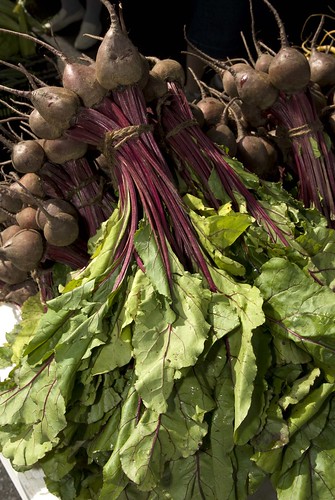Tip of the Week: Can’t Beat Growing Beets
Posted in Gardening Tips on August 17 2009, by Sonia Uyterhoeven
 |
Sonia Uyterhoeven is Gardener for Public Education. Join her each weekend for home gardening demonstrations on a variety of topics in the Home Gardening Center. |
 Even though beets never seem to make the Top Ten list of favorite vegetables, they deserve a place in everyone’s vegetable garden. Between the beet greens and the beet root, they are an excellent source of vitamins A, C, and several Bs (B1, B2, B6, and folic acid); calcium; manganese; potassium; iron; and fiber. Who would have thought that this sturdy little root vegetable packs so much punch!
Even though beets never seem to make the Top Ten list of favorite vegetables, they deserve a place in everyone’s vegetable garden. Between the beet greens and the beet root, they are an excellent source of vitamins A, C, and several Bs (B1, B2, B6, and folic acid); calcium; manganese; potassium; iron; and fiber. Who would have thought that this sturdy little root vegetable packs so much punch!
Incidentally, you will lose all of these nutrients if you peel the beets before you cook them, causing them to bleed. Cook them unpeeled with a little bit of the tops still intact and then peel and slice them. The minimal bleeding that occurs and any red stains that result can then easily be cleaned up with some lemon juice.
There are many ways to enjoy beets. You can pickle them, boil them, or roast them. Jamie Oliver has a wonderful recipe in which he slices them into hearty chunks and adds some thyme, olive oil, and garlic before wrapping them in tinfoil and tossing them in the oven. How easy it is to add spice to your vegetable life.
I usually mix the greens with Swiss chard. I chop all the greens into smaller pieces and toss them into a wok, first steaming them lightly and then stir frying them with olive oil. Garlic or the sweet Zante currants gets added into the mix depending on my mood.
Now that your taste buds have been tickled, here is the good news. Beets are easy to grow, and their foliage is so beautiful that beets have as much a place in an ornamental garden as in an edible garden.
For tasty and tender beets, it is important to start with good soil. Amend the soil with plenty of compost. If your soil pH is on the acidic side, it is worth adding lime. Beets prefer a soil pH of around 6.5. If you are not sure about your soil pH, take a soil test and send it to your co-operative extension.
If you feel like dressing your soil up even more, incorporate greensand or any of the dried seaweed products that are available on the market to add important trace elements to the soil. Compost generally adds enough of these trace elements on its own.
Take your garden fork and turn the planting area to a depth of 8-10 inches. This will not only help incorporate the organic matter, but it will also relieve any soil compaction and make it possible for the root vegetable to grow unhindered.
There are a number of seasons in which to sow your beets. You can sow them in the spring beginning 2-3 weeks before the last frost date in your area. Successive planting— where you stagger your crop—makes a lot of sense. Sow them at 2-3 week intervals all the way until the end of June. You can also sow them in the beginning of August for a late-season harvest. This will be a fast crop for the fall that can be harvested when the beets are still young.
Seeds sometimes germinate inconsistently so sow 1 inch apart and then thin once the leaves are 1-2 inches tall. It is best to thin the plants by cutting off the tops rather than pulling them out (so you don’t disturb the soil). Toss the thinnings into your salads.
If you are growing beets for the greens, you do not have to thin. Grow until 6 inches tall and harvest. If you are growing them for the roots, thin 4-6 inches apart. Beets are incredibly tender when they are harvested young. Greens take approximately 35 days to grow while the roots take 50-60 days to develop.
Catalogs offer a wonderful selection to choose from: ‘Detroit Dark Red’ is a classic, ‘Burpee’s Golden’ is a sweet yellow selection that doesn’t bleed and is perfect for salads, ‘Chioggia’ is an Italian beet that has concentric rings of white and red (that unfortunately disappear when cooked), and ‘Bull’s Blood’ has deep red foliage.

